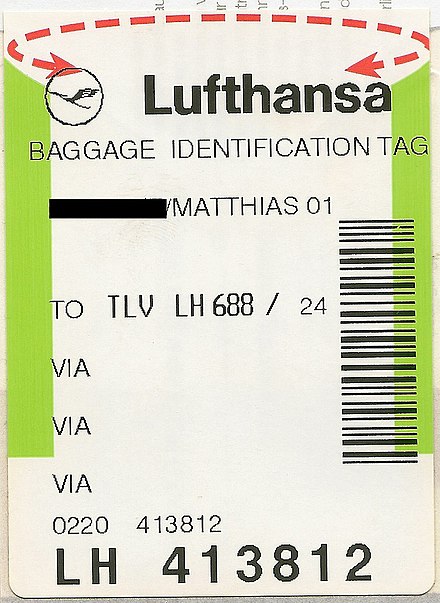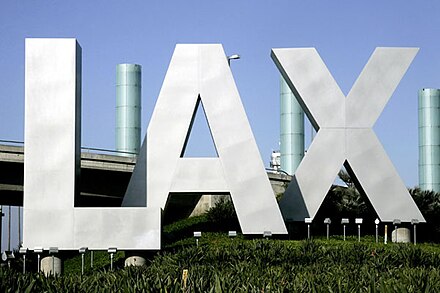Airport names are often abbreviated by codes, including IATA codes and ICAO codes, that are only a few characters in length. Knowing them can be useful for orientation, booking or conversation.
IATA
The International Air Transport Association defines a three-letter code for airports and a two-letter code for individual major airlines. These codes, which are intended to be globally unique, are used for ticketing, for booking flights and on baggage tags.

 It's useful to know the code of the airport you are travelling to:
It's useful to know the code of the airport you are travelling to:
- Some large cities are served by more than one airport - either in the city itself or a suburb. London, for instance, is served by three major airports — Heathrow Airport (IATA: LHR), Gatwick Airport (IATA: LGW), Stansted (IATA: STN) — and three others. There is also the code IATA: LON which covers all six of those airports; generally it is best to use that when searching for flights.
- Some airlines also deceptively name small airports after big cities. Hahn is closer to Luxembourg than to Frankfurt, but marketers are happy to sell "Frankfurt" flights that land in Hahn. Girona has few things in common with Barcelona and Weeze is not really Düsseldorf.
- Some cities have identical names; Portland (Oregon) was named for Portland (Maine) but is on the opposite coast. Sydney (Nova Scotia) and Sydney (New South Wales) are as separate as night and day, or summer and winter, as they're half a world apart. You would not want to end up at the wrong Birmingham or Manchester either.
- Some airports also have confusingly similar names, but serve different cities.The code is a useful confirmation that you have a ticket to the correct town, that the travel agent did not mishear Calgary (IATA: YYC) as Cagliari (IATA: CAG) for example. Or you are going to the correct San Salvador or Santa Rosa airport and to distinguish airports with the same or similar name, such as which Alexander the Great Airport (IATA: KVA or IATA: SKP)?
- Some airports or cities offer flights to multiple, confusingly-similar destinations. There are two different flights from Toronto to Kingston. One's intraprovincial (IATA: YGK), the other's going to Jamaica (IATA: KIN).
- To make the confusion complete, tiny Nogales is divided by the Arizona-Sonora border with a different single-runway Nogales International Airport serving general aviation on each side of the USA-México boundary.
Using the codes can make entering destinations on airline web sites quicker. On check-in, they're useful as a quick visual check that the luggage tag is sending your belongings to where you are travelling, or that the airline has not made a last minute change.
 Many airports are known by their code and referenced by local public transport with them and thus the codes can be useful when communicating with taxi drivers. To give just one example, the most convenient bus line to Tegel Airport in Berlin is line TXL. They may also appear in diverse contexts as a colloquial nickname for the city which the airport serves.
Many airports are known by their code and referenced by local public transport with them and thus the codes can be useful when communicating with taxi drivers. To give just one example, the most convenient bus line to Tegel Airport in Berlin is line TXL. They may also appear in diverse contexts as a colloquial nickname for the city which the airport serves.
In general, IATA assigns two-letter codes to airlines and three-letter codes to airports; three-letter codes for non-aviation facilities (such as rail stations with no associated airport) most often begin with Q, X or Z. Codes beginning with Y have for historical reasons mostly been assigned to Canadian airports.
ICAO
ICAO codes are assigned by the International Civil Aviation Organization, a specialized agency of the United Nations. These four-letter codes are used by aviators for flight plans and navigation; they are separate and different from IATA codes, which are generally used by travel companies for airline timetables, reservations, and baggage tags. For example, the IATA code for London's Heathrow Airport is LHR and its ICAO code is EGLL. ICAO codes are commonly seen by passengers and the general public on flight-tracking services, though passengers will more often see the IATA codes, on their tickets and their luggage tags.
In general IATA codes are usually derived from the name of the airport or the city served, while ICAO codes are distributed by region and country. Far more aerodromes (in the broad sense) have ICAO codes than IATA codes, and to add to the confusion IATA codes (because of their use for ticketing) are sometimes assigned to railway stations. ZYP, for example, is Penn Station in New York City.
The first letter of the ICAO code identifies a geographic region, while the second letter usually identifies an individual country or region of a country within that region. Canada and the US Lower 48 mostly assign ICAO codes which match the same airport's IATA code, by adding a leading 'C' (Canada) or 'K' (USA 48). In other countries, there may be anywhere between a moderate correlation to no correlation between the IATA and ICAO codes.
While IATA codes for any given airport rarely change and sometimes even preserve an anachronistic former name (IATA: PEK for the main airport of Beijing for example), ICAO codes may and frequently do change when an airport comes under the control of a different country or government. For example, Berlin Schönefeld Airport remained IATA: SXF but changed its ICAO code upon German reunification as it passed from the GDR to the Federal Republic of Germany.
As IATA is used by travel companies for ticketing and baggage handling, an airport with no scheduled flights may have an ICAO code but no IATA code. There's no corresponding IATA tag for KXTA, the ICAO airport code for Area 51 – a closely-guarded military test strip at Groom Lake, Nevada which is not open to civilians.
Regional codes
There are other identifiers in use; national rail carriers (such as Amtrak) have been known to assign their own non-standard codes to train stations on their own lines and agencies of national governments will assign a location identifier to even the tiniest private landing strip - even if there are no other facilities, no passenger terminal, no tickets and no IATA tags.
In some cases, there's nothing there but a bit of open lake suitable for a float plane; a water aerodrome is open water used regularly to land seaplanes or amphibious aircraft, but typically has no facilities and only a regional location identifier (LID). For instance, "Yellowknife Water Aerodrome" holds a national location identifier (TC LID: CEN9) as Air Tindi Ltd's favourite seasonal spot to land on Great Slave Lake; when a carrier stops using the spot, the identifier is normally revoked.
- In Canada, Transport Canada assigns two, three, and four character location identifiers. The TCLID will most often be the same as the IATA code for major passenger airports; a small private airstrip may have just a TCLID. These are not globally unique, but usually avoid overlapping individual FAA LID codes.
- In Mexico the Direction General of Civil Aeronautics issues three-letter designators to airports, private airstrips, heliports, boat-heliports and helipads.
- In Russia (and, historically, the Soviet Union) an internal code (внутренней код) has three Cyrillic letters. These may be used for ticketing and have changed if the name of a city changes.
- In the United States of America the Federal Aviation Administration location identifier (FAA LID) is a three- to five-character alphanumeric code identifying aviation related facilities. It will most often be the same as the IATA code for major passenger airports; a small private airstrip will have a string of three or four letters and numbers. A leading 'N' is usually a current or former military base (hence the use of EWR for the civil airport at Newark). Historically, the US National Weather Service also had several schemes for identifying stations (so the 'LA' weather station ID became 'LAX' as an IATA destination), but it now relies on the ICAO and WMO identifiers.
Other identifiers include:
- ITU callsigns for radio stations. These are mostly globally unique as the first few characters identify the country; while mostly used for non-aviation purposes, numbers from this series may identify individual aircraft (for instance, N and a long number on the fuselage of a US plane, CF- and three letters in Canada or F- for a French aircraft).
- World Meteorological Organisation (WMO) identifiers, typically five-digit numeric values, uniquely identify weather stations.
- ICAO has its own standard for weather information, whose predefined message format is the keyword "METAR", followed by the four-letter ICAO location code and the measured data. These re-use the existing ICAO airport identifiers, with one exception: The United States Air Force Weather Agency (AFWA) may assign special-use identifiers beginning with "KQ" to deployed units which lack a permanent code, are mobile or in classified operating locations.
- UN/LOCODE, the United Nations Code for Trade and Transport Locations, assigns five-letter codes to trade and transport locations such as seaports, rail and road terminals, airports, Postal Exchange Office and border crossing points. The first two letters are the country code, so "US NYC" is New York City.
See also
- A list of all airport codes can be found on Wikipedia.
- Metropolitan area airport codes
- Airport articles
- City and Region articles with airport listing for an airport.
- Template , used to reference an airport in an article.
- Template , used to reference generally small airfields in the USA. w:FAA LID
- Wikivoyage:Airport Expedition